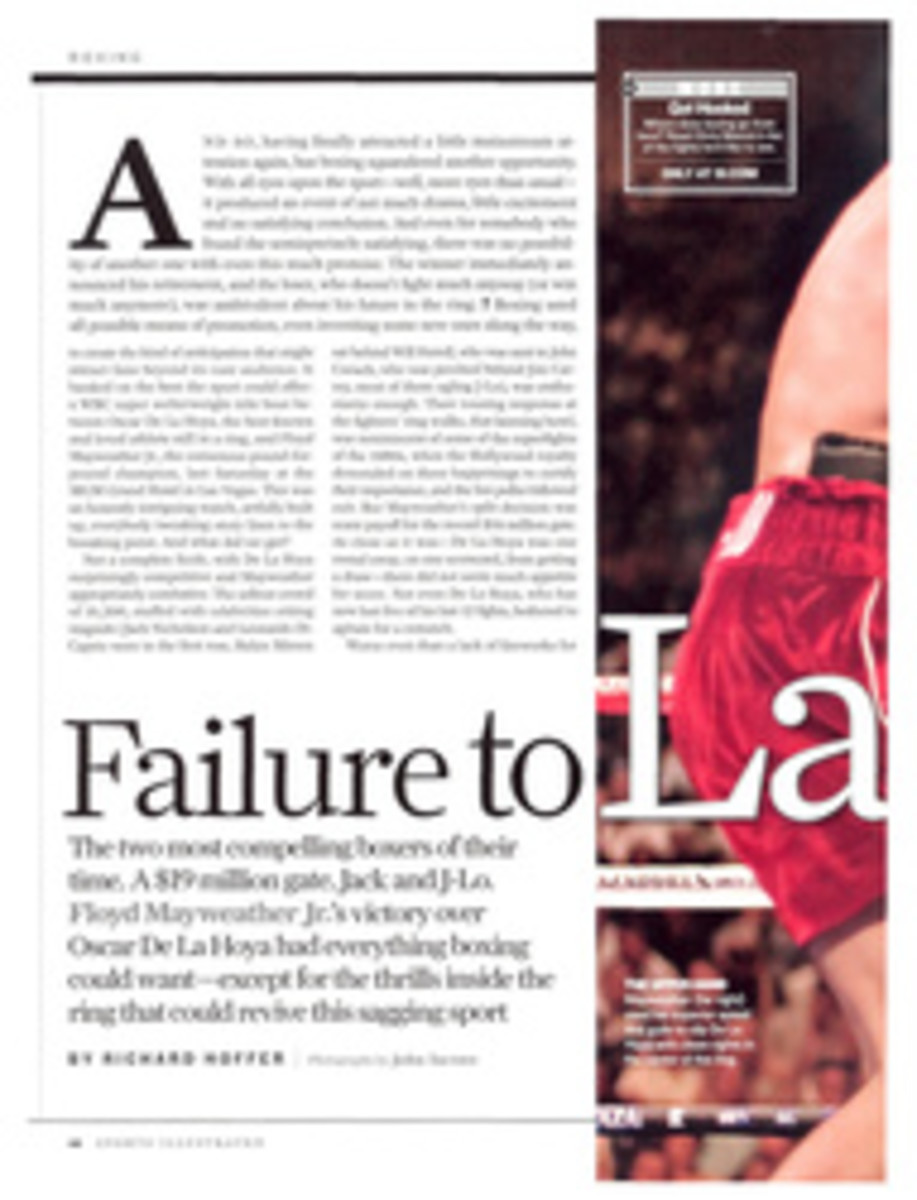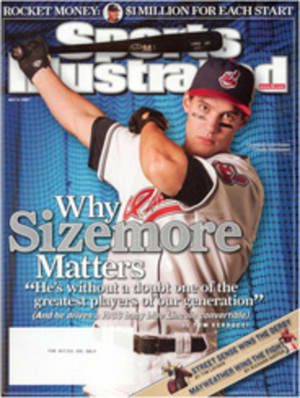
Failure to Launch
And so, havingfinally attracted a little mainstream attention again, has boxing squanderedanother opportunity. With all eyes upon the sport--well, more eyes thanusual--it produced an event of not much drama, little excitement and nosatisfying conclusion. And even for somebody who found the semispectaclesatisfying, there was no possibility of another one with even this muchpromise. The winner immediately announced his retirement, and the loser, whodoesn't fight much anyway (or win much anymore), was ambivalent about hisfuture in the ring. ¶ Boxing used all possible means of promotion, eveninventing some new ones along the way, to create the kind of anticipation thatmight attract fans beyond its core audience. It banked on the best the sportcould offer: a WBC super welterweight title bout between Oscar De La Hoya, thebest-known and loved athlete still in a ring, and Floyd Mayweather Jr., theconsensus pound-for-pound champion, last Saturday at the MGM Grand Hotel in LasVegas. This was an honestly intriguing match, artfully built up, everybodytweaking story lines to the breaking point. And what did we get?
Not a completefizzle, with De La Hoya surprisingly competitive and Mayweather appropriatelycombative. The sellout crowd of 16,200, stuffed with celebrities sittingringside (Jack Nicholson and Leonardo DiCaprio were in the first row, HelenMirren sat behind Will Ferrell, who was next to John Cusack, who was perchedbehind Jim Carrey, most of them ogling J-Lo), was enthusiastic enough. Theirrousing response at the fighters' ring walks, that keening howl, wasreminiscent of some of the superfights of the 1980s, when the Hollywood royaltydescended on these happenings to certify their importance, and the hoi polloifollowed suit. But Mayweather's split decision was scant payoff for the record$19 million gate. As close as it was--De La Hoya was one round away, on onescorecard, from getting a draw--there did not seem much appetite for more. Noteven De La Hoya, who has now lost five of his last 12 fights, bothered toagitate for a rematch.
Worse even than alack of fireworks for a Fourth of July kind of crowd was the feeling thatconditions would never again be quite this right to rejuvenate a sport that isincreasingly marginalized and fragmented. Boxing has become so globalized thatAmerican fans have few rooting interests anymore (especially in theall-important heavyweight division). It might be impossible ever to produceeven another Mayweather, much less a De La Hoya, who both had Olympic and freeTV exposure in their career infancies. The pay-per-view model that boxing nowfavors is fatally shortsighted; it produces unimaginable purses for the elitefew but further constricts the fan base to the purist. No fighter again willhave the wide recognition of these two.
Afterward,Mayweather insisted anew that he was taking his wealth and fast hands to someother platform of fame--record producing, perhaps. "I came in on top, I'mleaving on top," he said. No pugilist in recent history has left the gameundefeated at the age of 30, drawing a $10 million payday in his final fight.But Mayweather, a five-time champ in five divisions, just might be contraryenough to do it.
As for the34-year-old De La Hoya, whose charm and left hook have earned him more than$500 million in pay-per-view buys--probably more than even Mike Tyson orEvander Holyfield after Saturday's haul is finally counted--the future in thering is even less certain. As valiant as he was in his underdog role againstMayweather, he has now lost to almost every great fighter he's faced: FelixTrinidad, Bernard Hopkins, Shane Mosley. His crossover appeal is such that hewill remain an attraction long after he can honorably compete, but let's notforget that he is more businessman than fighter these days (his company, GoldenBoy, promoted the fight) and, more important, that he fights only every year ortwo.
If the matchdidn't live up to expectations, it might be that those expectations wereunreasonable. It wasn't the fault of the fighters, who came into the bout insensational shape. Mayweather is always in condition. But De La Hoya, whoseinterests are more varied as he pursues mogul-dom, has been known to run out ofgas in the late rounds. That he displayed rippling abs at the weigh-in bespokehis renewed dedication to the sport.
So there was a lotof honest effort involved. Early on, De La Hoya seemed to have a game plan foran upset, using his larger frame to bully Mayweather into the ropes and punishhis body. And whenever De La Hoya used his jab, he found his mark. But heneglected the weapon as the fight wore on and afterward was at a loss toexplain its failure to deploy. "My jab just didn't come out," hesaid.
Mayweather,meanwhile, having agreed to move up to 154 pounds to meet De La Hoya--in fact,having agreed to every condition the belt holder set, including accepting lessthan half the champion's $25 million purse--was able to deflect most of thepunishment and, on those occasions when he halted De La Hoya in the center ofthe ring, used his fabled hand speed to clip him with clean rights.
Common wisdom heldthat De La Hoya couldn't penetrate Mayweather's buzz saw counter-punching, butthe fight went back and forth, De La Hoya winning the early rounds when heunfurled his jab and set the pace, Mayweather responding with torridcounterpunching. De La Hoya may not have hurt Mayweather at any point, but hisaggression was certainly bold. And his swarming of Mayweather on the ropes,which Mayweather at first permitted, may have helped him to steal a couple ofrounds.
But the decidedlypro-Oscar crowd--there is hardly anything more traditional in boxing than aCinco de Mayo event headlined by De La Hoya--just couldn't get any traction.And it wasn't because Mayweather had purloined their affections with hisplayful decision to wear a huge white sombrero into the ring. De La Hoya simplyfailed to mount a sustained attack and was too often caught up short byMayweather's snapping fists. In the 10th round, for example, De La Hoya wasslugging along when Mayweather simply popped him flush in the face with a righthand, driving him backward. So much for that.
It was only in thefinal round that the two fully engaged, when De La Hoya unleashed a desperatefirestorm. That round proved crucial. Two of the three judges gave it to De LaHoya. Had the third also scored it for him, the decision would have been adraw. Still, as close as it was, there was not a lot of surprise or evenoutrage at the decision. It just seemed it could have gone either way,depending on whether you rewarded De La Hoya's body shots and his forcing theaction, or Mayweather's superior accuracy. Oddly, the person who seemed most atpeace with the verdict was De La Hoya. "I don't feel like a loser," hesaid. "I'm satisfied."
The prefightpromotion, for its part, didn't lack for effort, or even innovation. Inaddition to the old standbys--an 11-city publicity tour, an itinerary ofenforced aggravation, considering Mayweather's fabled impishness--there werecorporate tie-ins, a striking array of sponsorships and a pretty good adcampaign. Tecate, one of those sponsors, said the partnership produced some ofits biggest beer sales ever for a month. Presumably it worked the other way,too.
The newest trickfor this old dog was HBO's decision to create a four-part reality show thataired after The Sopranos. The half-hour program, 24/7, showed each fighterduring the routine of training camp. In De La Hoya's case that includeddelivering a cake and a Mariachi band for his wife's birthday. In Mayweather's,it involved the careful stacking of $100 bills on his kitchen counter. The showhad a WWE genius to it, editing a hero and a heel out of its month of footage,as if those roles hadn't already been established. Mayweather has long sinceembraced his villainy and shrugged off HBO's reinforcing it. "I did wishthey had showed me taking my kids to Chuck E. Cheese," he said before thefight. But how would that have sold the fight?
The show sureturned Mayweather into a star in the reality genre; he has been offered twoadditional shows. If he really does retire, he can devote himself even morefully to being Floyd, though he might never again have so many $100 bills tofling at the camera. Or he could focus on repairing the fragile relationshipswithin the Mayweather family, which were further fractured during the lead-upto the fight. Floyd Sr., who trained De La Hoya until he demanded $2 million toremain in De La Hoya's corner, was replaced by Freddie Roach in January andtried to return to his son's camp. But Floyd Jr. already had his father'syounger brother Roger, who resumed coaching his nephew after serving six monthsin prison for assault, in his corner. The two brothers, who haven't spoken in10 years, commingled, however uncomfortably, in the gym in the weeks before thefight, as if in service of a single purpose.
But Mayweathersare like quantum particles; the act of observation alone is enough to throw thephysics out of whack. And so 24/7, picking up on Floyd Jr.'s preference for hisuncle's training style, drove another wedge between father and son. Floyd Sr.was out of the camp, and the loop, before the fourth episode aired. Theestrangement prompted De La Hoya to offer his former trainer four ringsideseats. "This man has trained me for six years," said De La Hoya."It's the least I could do."
The idea of De LaHoya's working the situation to his favor--good guy again!--annoyed Floyd Jr."Four seats," sniffed Mayweather at the weigh-in. "That ain't no $2million, is it?" Floyd Sr. munched popcorn during the fight and hugged hisson afterward. Then he said that he thought De La Hoya had won.
So many storylines ought to have been provocative enough to lure a record audience for anon-heavyweight fight. It will be days before HBO can tally the pay-per-viewaudience and determine if it outsold De La Hoya's 1999 fight with FelixTrinidad, when 1.4 million paid for the show, or the record 1.99 million buysfor Mike Tyson's second fight with Evander Holyfield, in 1997. But early signswere good, whether it was a three-hour sellout of the MGM Grand or just theall-around buzz, especially in Las Vegas. While nobody was comparing this withSugar Ray Leonard versus Thomas Hearns from 1981--arguably the most anticipatednon-heavyweight fight of all time--everybody agreed it was a genuine megafight.When was the last time 5,500 people showed up for a weigh-in, with thousandsmore turned away?
That's why it wasso important that the fight capitalize on such an investment of ingenuity andeffort, because these unique resources and talents--whether it was Mayweather'shands and choice of infamy over De La Hoya's more carefully developed careerand charisma--may never be gathered in one place again. And that's why thisfight had to deliver more than just a super-high level of competence, anexaggerated degree of dedication, an honest display of skill. This fightdelivered those, which is all you can normally ask, but these are moredesperate times for boxing. Sadly, it failed to produce that hair-raisingmoment, the chill up the back of your spine that guarantees you'll be back formore of this, next time, whenever or wherever that is.
MORE
Get Hooked
Where does boxing go from here? Read Chris Mannix'slist of the fights he'd like to see.
ONLY AT SI.COM
Mayweather insisted that he was taking his wealth andfast hands to another platform of fame. "I came in on top, I'm LEAVING ONTOP," he said.
As valiant as he was in his underdog role againstMayweather, De La Hoya has now LOST TO ALMOST EVERY GREAT FIGHTER he hasfaced.
PHOTO
John Iacono
THE UPPER HAND Mayweather (far right) used his superior speed and guile to clip De La Hoya with clean rights in the center of the ring.
PHOTO
JAE C. HONG/AP
HEAD GAME Mayweather tried to win over De La Hoya fans with his haberdashery.
PHOTO
John Iacono
FATHER KNOWS BEST? Mayweather Sr. said he thought De La Hoya had won.

